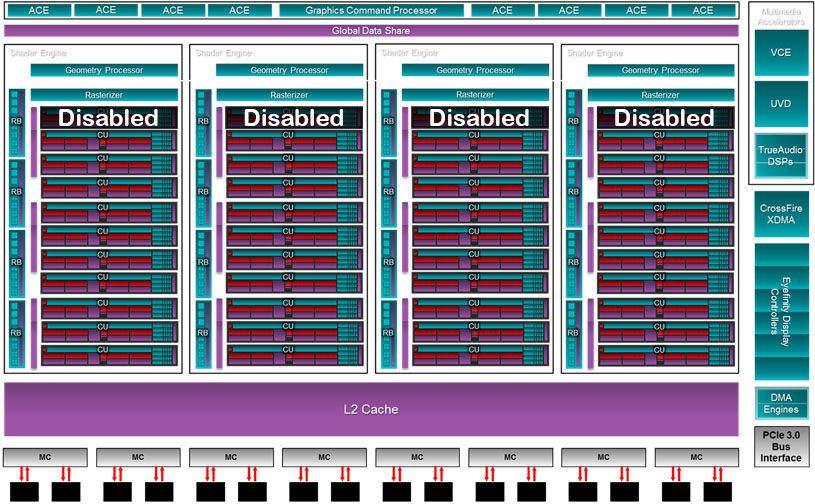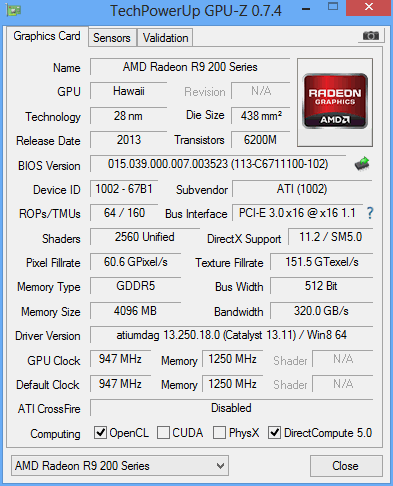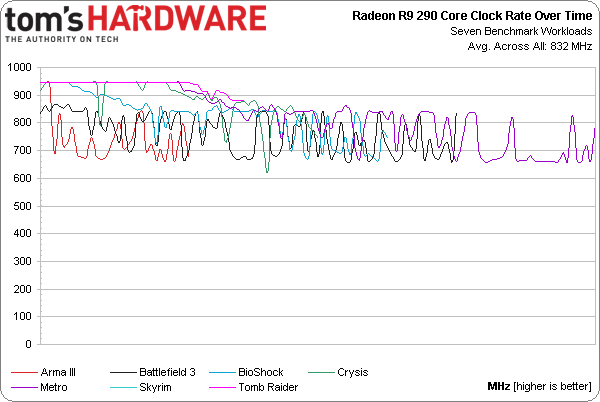AMD Radeon R9 290 Review: Fast And $400, But Is It Consistent?
We have all the makings of a dramatic launch: new high-end hardware, a last-minute delay for more performance, a crazy twist based on retail hardware, and our own home-baked solution to AMD's noise problem. Does Radeon R9 290 impress us or fall short?
Digging Deeper Into Hawaii’s Behavior
The reactions to last month’s Radeon R9 290X launch were polarizing, to say the least. On one hand, you had this new GPU largely based on a familiar architecture, but still equipped with new technology and, overall, typically faster than GeForce GTX 780 and Titan. On the other, it proved to be power-hungry, purportedly designed to run at a cringe-inducing 95 °C, and cooled by a fan that gets very loud, if you let it.
So two factions faced off—those who saw the value in a very fast gaming card priced hundreds of dollars less than the competition, versus others who weren’t impressed by a new GPU edging out Nvidia’s eight-month-old flagship.
Regardless of which side you chose, we can all agree that more performance at a lower price point is good for PC gaming, though. Just look at the aftermath: Nvidia dropped the GeForce GTX 770 to an attractive $330 and its GeForce GTX 780 to $500. We even know now that the GeForce GTX 780 Ti will go for $700 when it emerges.
Adding value is exactly what today is about, too. Using the same Hawaii GPU it just unveiled, AMD is introducing a Radeon R9 290.
Hawaii Gets A Haircut
The R9 290 is a derivative product, which means its specifications don’t fall far from the 290X. As you know, Hawaii is a 6.2-billion transistor processor manufactured at 28 nm. But instead of enabling all 44 of its Compute Units, AMD fuses off four of them, dropping the chip’s shader count to 2560 (from 2816). This has the dual effect of trimming texture units from 176 to 160. Although AMD isn’t specific about the four CUs that get disabled, company representatives do say they’re turned off in a manner to yield consistent performance from one board to the next.
And to clarify a point from my R9 290X review: Hawaii doesn’t offer 1/4-rate double-precision compute like Tahiti did. Instead, AMD drops DP performance to one-eighth of the chip’s FP32 throughput, and instead saves the more potent compute potential for its FirePro cards, taking a page out of Nvidia’s playbook. That makes the 290’s peak floating-point performance about 4.84 TFLOPS, while its DP rate is 606 GFLOPS.
| Header Cell - Column 0 | Radeon R9 290X | Radeon R9 290 | Radeon R9 280X | GeForce GTX Titan | GeForce GTX 780 |
|---|---|---|---|---|---|
| Process | 28 nm | 28 nm | 28 nm | 28 nm | 28 nm |
| Transistors | 6.2 Billion | 6.2 Billion | 4.3 Billion | 7.1 Billion | 7.1 Billion |
| GPU Clock | Up to 1 GHz | Up to 947 MHz | 1 GHz | 836 MHz | 863 MHz |
| Shaders | 2816 | 2560 | 2048 | 2688 | 2304 |
| FP32 Performance | 5.6 TFLOPS | 4.8 TFLOPS | 4.1 TFLOPS | 4.5 TFLOPS | 4.0 TFLOPS |
| Texture Units | 176 | 160 | 128 | 224 | 192 |
| Texture Fillrate | 176 GT/s | 152 GT/s | 128 GT/s | 188 GT/s | 166 GT/s |
| ROPs | 64 | 64 | 32 | 48 | 48 |
| Pixel Fillrate | 64 GP/s | 61 GP/s | 32 GP/s | 40 GP/s | 41 GP/s |
| Memory Bus | 512-bit | 512-bit | 384-bit | 384-bit | 384-bit |
| Memory | 4 GB GDDR5 | 4 GB GDDR5 | 3 GB GDDR5 | 6 GB GDDR5 | 3 GB GDDR5 |
| Memory Data Rate | 5 Gb/s | 5 Gb/s | 6 Gb/s | 6 Gb/s | 6 Gb/s |
| Memory Bandwidth | 320 GB/s | 320 GB/s | 288 GB/s | 288 GB/s | 288 GB/s |
| Board Power | 250 W (Claimed) | 250 W (Claimed) | 250 W | 250 W | 250 W |
Hawaii’s other vital specs remain remarkably intact, though. A geometry engine in each of four Shader Engines maintains as many primitives per cycle. Every Shader Engine is also equipped with four render back-ends, enabling up to 64 pixels per clock across the GPU. The aggregate 512-bit memory bus carries over as well, and Radeon R9 290 sports the same 4 GB of 1250 MHz GDDR5 RAM.
Get Tom's Hardware's best news and in-depth reviews, straight to your inbox.
With so many similarities between R9 290X and 290, aside from shader count, AMD also dials back maximum frequency to keep the two cards from landing on top of each other in performance. The 290X runs at up to 1 GHz, while Radeon R9 290 peaks at 947 MHz.
Clock Rate Inflation: Marketing Gone (Too) Wild
Let’s talk a little bit about core clock rates though, since that was a point of contention from Radeon R9 290X Review: AMD's Back In Ultra-High-End Gaming. In essence, it appears that AMD has a base clock rate around 727 MHz with its R9 290X, though the Hawaii GPU wants to run as close to 1000 MHz as possible. By the time the chip approaches its 95-degree ceiling, you’ll probably find the fan already spinning at 40% duty cycle using AMD’s “Quiet” firmware. From there, the GPU clocks down. Depending on the chip’s quality and the workload you run, Hawaii might slide all the way to 727 MHz and stay there if its fan can’t keep it cool enough.
On the R9 290X we received from AMD, and in the seven games we tested, a 40% fan speed is good enough to average about 874 MHz. But when you’re actually gaming on a hot card (and not just benchmarking a cold one), our two-minute Metro: Last Light test suggests you’ll be spending more of your time in the upper-700 MHz range. In fact, in some titles, you’ll dip under 1000 MHz before even getting out of the menu system and into the action (Arma and BioShock).
You could call that questionable marketing. After all, the only way you’ll actually see a sustained 1000 MHz is if you either let the R9 290X’s fan howl like a tomcat looking for action or play platform-bound games. Then again, if you’re still seeing better performance from 290X than competing cards, what does it matter how Hawaii gets there, right?
With that in mind, how does the R9 290 fare in comparison?
I maintained the same scale and enforced the same 40% fan speed limit to give you an idea of how much more variance there is between the troughs and crests. AMD gives the 290 an “up to” rating of 947 MHz, but our seven games average 832 MHz. In the most taxing situations, the clock rate floor, or base clock, appears to be 662 MHz. If the GPU can’t be kept cool, even down at that base frequency, you’ll see the 40% fan limit forcibly exceeded (it crept up to 44% in a three-run stress test of Metro: Last Light).
When you think about it, this is basically the reverse of Nvidia’s GPU Boost technology. AMD is selling its cards using the highest-possible frequency you’ll see, and then slowing them down. Nvidia is citing a base clock and then allowing the GPU’s headroom to push higher. The company makes it a point to specify the base and typical boost numbers, though. AMD’s scheme undoubtedly suffers a lack of clarity, and after piling praise onto the R9 290X’s value story, I now have to hope that Nvidia doesn’t follow AMD down this muddy little rabbit hole.
Ultimately, the performance figures are what matter most. Just be careful before drawing definitive conclusions. The longer you run any of these tests at stock settings on AMD’s reference design, the more averages will come away from the rated 947 MHz figure. Our sample doesn’t have a Quiet and Uber mode. Both of its firmware switch positions share the same 40% fan speed maximum. And to complicate the situation, prior to launch, AMD rolled out an updated driver that overrides the BIOS setting in software to allow fan speeds up to 47% by default. What is the impact of that modification?
As we know, overcoming AMD’s throttling mechanism requires manually increasing the OverDrive applet’s maximum duty cycle. By upping its shipping fan speed from 40% to 47%, AMD allows its reference cooler to blow harder, maintaining higher frequencies for longer durations, at the expense of greatly increased noise. Once again, we find ourselves pinning hopes for a quieter, more consistent R9 290 on the company’s partners.
But all we have for now is the reference design. With that in mind, let’s have a look at the Radeon R9 290 itself.
Current page: Digging Deeper Into Hawaii’s Behavior
Next Page Sidebar: Variability Turns Into A Graphics Card Crapshoot




